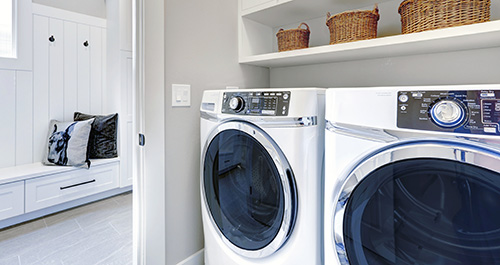To compare appliances, evaluate key features, energy efficiency, and prices. Read customer reviews and expert opinions for informed decisions.
Selecting the right appliances can significantly enhance your home’s functionality and aesthetic. To make an informed choice, start by identifying the essential features you need. Energy efficiency is crucial for long-term savings and environmental impact, so look for Energy Star ratings.
Comparing prices across various retailers ensures you get the best deal, but don’t forget to include additional costs like delivery and installation. Customer reviews and expert advice provide valuable insights into performance and reliability. By following these steps, you can confidently choose appliances that meet your needs and budget, ensuring a well-equipped and efficient home.
Credit: www.netify.com
Before You Begin: Establishing Your Needs
Before you dive into comparing appliances, take a moment to establish your needs. Knowing what you require will make the comparison process smoother and more effective. This section will guide you through assessing your lifestyle, kitchen usage, and budget considerations.
Assessing Your Lifestyle And Kitchen Usage
Your lifestyle plays a crucial role in determining the right appliances. Do you cook daily or only on weekends? Do you often entertain guests?
- If you cook daily, invest in durable, high-quality appliances.
- For occasional cooking, mid-range options may suffice.
Consider your kitchen usage patterns. Do you need a large refrigerator or a compact one? List down your daily kitchen activities.
| Activity | Appliance Needed |
|---|---|
| Daily Cooking | High-Quality Stove |
| Frequent Baking | Reliable Oven |
| Quick Meals | Microwave |
Setting A Realistic Budget
Setting a realistic budget is essential. Knowing your financial limits helps you narrow down your choices efficiently.
- Determine your maximum spending limit.
- Allocate funds for each appliance category.
- Consider additional costs like delivery and installation.
Budgeting tips:
- Research average prices for the appliances you need.
- Look for seasonal sales or discounts.
- Check for bundled deals that offer savings.
Size Matters: Finding The Right Fit
Choosing the right appliance isn’t just about features and price. The size of the appliance is crucial to ensure it fits perfectly in your designated space. A well-fitting appliance not only looks good but also functions efficiently. Let’s dive into the key considerations to find the right fit.
Measuring Your Space
Before purchasing any appliance, measure the space where it will reside. Use a tape measure to get accurate dimensions.
- Height: Measure from the floor to the top of the space.
- Width: Measure from one side to the other.
- Depth: Measure from the back to the front edge.
Consider any obstructions like cabinet doors, walls, or other appliances. Leave extra room for ventilation and easy access.
Considering Appliance Dimensions
Compare your space measurements with the appliance dimensions. Appliance dimensions are usually listed in product descriptions.
| Appliance | Standard Dimensions |
|---|---|
| Refrigerator | 70″ H x 36″ W x 33″ D |
| Dishwasher | 35″ H x 24″ W x 24″ D |
| Oven | 36″ H x 30″ W x 25″ D |
Check for any model-specific variations. Always ensure you have space for opening doors and drawers.
Brand Matters: To Match Or Not To Match
When buying new appliances for your home, one of the key considerations is whether to stick to a single brand or mix and match. This decision can impact both the aesthetic and functional aspects of your kitchen or laundry room. Let’s explore the pros and cons of brand consistency and the effects of mixing different brands.
Pros And Cons Of Brand Consistency
Sticking to a single brand for all your appliances can offer several advantages:
- Unified Aesthetic: Matching brands often means a cohesive look with similar design elements.
- Ease of Use: Consistent controls and interfaces make usage more intuitive.
- Bundled Deals: Many manufacturers offer discounts when purchasing multiple appliances from the same brand.
However, there are also some disadvantages:
- Limited Choices: You may have fewer options if you stick to one brand.
- Higher Costs: Some brands are more expensive, limiting your budget.
- Potential Compromises: You might sacrifice quality in certain appliances just to match the brand.
The Aesthetic And Functional Impact Of Mixing Brands
Mixing different brands can also have its benefits and drawbacks:
| Pros | Cons |
|---|---|
| More freedom to choose the best features of each appliance. | Possible clashing designs or finishes. |
| Potential for cost savings by selecting budget-friendly options. | Different control interfaces can be confusing. |
| Opportunity to personalize your kitchen’s functionality. | Fewer opportunities for bundled discounts. |
Mixing brands allows for greater personalization. You can select the best appliance based on specific needs, ensuring you get the best performance and features. This approach can lead to a more functional and versatile kitchen or laundry room.
On the flip side, a mixed-brand setup might lack the seamless look of a matched set. Different control panels and interfaces can also pose a learning curve, making daily tasks slightly more complicated.
Ultimately, the choice between matching or mixing brands depends on your priorities and preferences. Consider both the aesthetic appeal and the practical functionality to make the best decision for your home.
Price Tag Beyond The Tag: Hidden Costs
When comparing appliances, the sticker price isn’t the only cost. Hidden costs can significantly impact your budget. These may include delivery, haul-away, installation fees, and long-term energy consumption costs. Understanding these hidden costs helps make a well-informed decision.
Delivery, Haul-away, And Installation Fees
Some stores include fees for delivery, haul-away, and installation in the appliance price. Others charge separately. These costs can add up quickly.
| Service | Average Cost |
|---|---|
| Delivery | $50 – $100 |
| Haul-away | $20 – $50 |
| Installation | $100 – $200 |
Many stores offer free delivery if you spend a certain amount. Always ask about these fees upfront to avoid surprises.
Long-term Energy Consumption Costs
Energy efficiency is a key factor when comparing appliances. An energy-efficient appliance may have a higher upfront cost but saves money in the long run.
- Look for the Energy Star label
- Check the annual energy consumption in kilowatt-hours (kWh)
- Compare the kWh usage of different models
Use the formula below to estimate annual energy costs:
Annual Cost = (kWh per year) (Electricity rate per kWh)
For example, if an appliance uses 500 kWh per year and your electricity rate is $0.12 per kWh:
Annual Cost = 500 kWh $0.12/kWh = $60
Choosing a more energy-efficient model can save you hundreds over its lifespan.
Efficiency And Environment: Energy Star And Beyond
When shopping for new appliances, efficiency and environmental impact are key. Understanding the significance of Energy Star ratings and other eco-friendly features can help you make informed decisions. This section delves into the importance of energy-efficient appliances and the potential savings through rebates and incentives.
Understanding Energy Efficient Appliances
Energy-efficient appliances use less energy to perform their tasks. They help you save on utility bills and reduce your carbon footprint. The Energy Star label is a reliable indicator of an appliance’s efficiency.
- Energy Star: Appliances with this label meet strict energy efficiency guidelines set by the EPA.
- Eco-Friendly Features: Look for features like low water usage in dishwashers and washing machines.
Energy-efficient appliances may cost more upfront, but they offer savings over time. This table highlights some common appliances and their potential savings:
| Appliance | Annual Savings |
|---|---|
| Refrigerator | $50 |
| Washing Machine | $30 |
| Dishwasher | $20 |
Rebates And Incentives For Eco-friendly Choices
Many governments and utilities offer rebates for purchasing energy-efficient appliances. These rebates can offset the higher initial cost. Here are some common incentives:
- Federal Tax Credits: Some eco-friendly appliances qualify for tax credits.
- State Rebates: Many states offer rebates for energy-efficient appliances.
- Utility Company Incentives: Local utility companies may offer rebates or discounts.
Check with your local utility company or government website for available rebates. This can significantly reduce your overall cost and promote an eco-friendly lifestyle.

Credit: www.directenergy.com
Comparing Features: What Really Matters
Choosing the right appliance can be daunting. With so many options, it’s crucial to know what features matter most. This guide will help you understand the essentials versus the extras, and the latest innovations in appliance technology.
Essential Features Vs. Nice-to-haves
When comparing appliances, separate essential features from nice-to-haves. Essential features are those that you cannot compromise on, while nice-to-haves are additional perks that enhance convenience but aren’t crucial.
| Essential Features | Nice-to-Haves |
|---|---|
|
|
Energy efficiency is a must. It saves money and helps the environment. Ensure the appliance has sufficient capacity for your needs. Basic functionality should cover all the primary tasks you expect.
Nice-to-have features include smart controls, which allow remote operation through apps. Advanced settings like specific cooking modes or washing cycles offer added convenience. Customizable options let you tailor the appliance to your preferences.
Innovations And Smart Technologies
Today’s appliances come with a variety of smart technologies. These innovations make household chores easier and more efficient.
Here are some of the most popular innovations:
- Smart Connectivity – Control your appliance from your smartphone.
- Voice Activation – Use voice commands to operate the appliance.
- Self-Diagnosis – The appliance can diagnose and report issues itself.
Smart connectivity allows you to monitor and control your appliance remotely. Voice activation integrates with digital assistants like Alexa or Google Assistant, making operation hands-free. Self-diagnosis features help you identify problems before they become serious.
With these innovative features, managing your home becomes seamless and efficient.
Warranty And Support: Preparing For The Future
When purchasing new appliances, ensuring you have solid warranty and support options is crucial. These factors safeguard your investment and provide peace of mind. Understand the coverage and services offered by different manufacturers.
Comparing Manufacturer Warranties
Not all warranties are created equal. It’s important to delve into the specifics of each warranty to know exactly what is covered and for how long. Here’s a helpful table to guide you:
| Manufacturer | Warranty Duration | Coverage Details |
|---|---|---|
| Samsung | 1 Year | Parts and Labor |
| LG | 2 Years | Parts and Labor |
| Whirlpool | 1 Year | Parts and Labor, 10 years for motor |
Check for additional warranties on specific parts, like motors or compressors. These often have extended coverage beyond the general warranty. Look for options that offer comprehensive protection.
Evaluating After-sales Services
After-sales services can vary significantly between manufacturers. High-quality support can save you time and money. Consider the following aspects:
- Customer Service Availability: Is support available 24/7?
- Service Centers: Are there authorized service centers nearby?
- Response Time: How quickly can a technician visit your home?
Here are some key points to evaluate:
- Online Support: Check if they have a robust online help center.
- Spare Parts Availability: Ensure parts are readily available.
- Service Plan Options: Look for extended service plans or maintenance packages.
Ultimately, strong warranty and support services are essential. They ensure your appliance runs smoothly for years.
Researching And Reviews: Making Informed Decisions
Buying new appliances can be overwhelming with so many options available. Making an informed decision requires thorough research and understanding user reviews. This section will guide you in comparing appliances effectively. Consider your specific needs and budget to narrow down the choices that best suit your lifestyle. Additionally, look for energy-efficient models that can save you money in the long run. For more guidance, be sure to check out these major appliance shopping tips that will help streamline your decision-making process.
Trusted Sources For Appliance Reviews
Start with trusted sources to get reliable appliance reviews. Websites like Consumer Reports, Good Housekeeping, and CNET offer detailed reviews based on expert testing.
These sources provide comprehensive evaluations on performance, durability, and value. Below is a table summarizing some of the best sources for appliance reviews:
| Source | Type of Review | Key Features |
|---|---|---|
| Consumer Reports | Expert Testing | Performance, Reliability, Safety |
| Good Housekeeping | Lab Testing | Durability, Ease of Use, Design |
| CNET | Tech Reviews | Innovation, Features, Pricing |
Leveraging Consumer Feedback
Consumer feedback is crucial for real-world insights. Look for customer reviews on websites like Amazon, Best Buy, and Home Depot.
- Amazon: Offers a wide range of user reviews.
- Best Buy: Provides detailed consumer ratings and feedback.
- Home Depot: Includes customer reviews and Q&A sections.
Pay attention to common themes in feedback. Look for patterns in performance and durability. For a balanced view, read both positive and negative reviews.
Here are some tips for evaluating consumer reviews:
- Look at the overall rating.
- Read multiple reviews for consistency.
- Check for verified purchases.
- Note any recurring issues.
Combining expert reviews with consumer feedback ensures a well-rounded understanding of the appliance’s performance.
The Final Verdict: Making The Purchase
After researching and comparing various appliances, it’s time to make your decision. This final step is crucial. You want to ensure you get the best value for your money. Here, we’ll discuss how to balance cost, features, and brand, and the best times to buy appliances to score great deals.
Balancing Cost, Features, And Brand
Finding the right balance between cost, features, and brand is key. Here’s a simple guide to help you:
| Aspect | Key Points |
|---|---|
| Cost |
|
| Features |
|
| Brand |
|
When To Buy: Timing Sales And Deals
Timing your purchase can save you a lot of money. Here’s when to look for the best deals:
- Holidays and Special Sales: Black Friday, Cyber Monday, and Labor Day offer big discounts.
- End-of-Season Sales: Buy appliances during clearance sales at the end of winter or summer.
- New Model Releases: Purchase older models when new ones hit the market, reducing prices.
Check store websites and sign up for newsletters. This way, you’ll be the first to know about sales and special deals.
Credit: www.eldersweb.net
Frequently Asked Questions
How To Compare Prices On Appliances?
Use price comparison websites like PriceGrabber and Google Shopping. Check store discounts, reviews, and include delivery fees.
What Brand Has The Best Kitchen Appliances?
Top brands for kitchen appliances include Samsung, Bosch, GE, and LG. They offer high-quality, reliable products.
How Do You Choose The Right Kitchen Appliances?
Choose the right kitchen appliances by assessing needs, setting a budget, considering size, checking energy efficiency, and reading reviews.
Is It Ok To Have Mismatched Appliance Brands?
Yes, it is fine to have mismatched appliance brands. Focus on functionality and design compatibility for the best results.
Conclusion
Choosing the right appliances can transform your home. Remember to consider your needs, budget, and energy efficiency. Read reviews, compare prices, and seek expert advice. These steps will help you make informed decisions, ensuring your appliances meet your lifestyle and preferences.
Happy shopping!



